
This drawing depicts the Annunciation to the Virgin Mary, as told in the Gospel of Luke:
And in the sixth month, the angel Gabriel was sent from God into a city of Galilee, called Nazareth, to a virgin espoused to a man whose name was Joseph, of the house of David; and the virgin’s name was Mary. And the angel being come in, said unto her: Hail, full of grace, the Lord is with thee: blessed art thou among women. Who having heard, was troubled at his saying, and thought with herself what manner of salutation this should be. And the angel said to her: Fear not, Mary, for thou hast found grace with God. Behold thou shalt conceive in thy womb, and shalt bring forth a son; and thou shalt call his name Jesus. He shall be great, and shall be called the Son of the most High; and the Lord God shall give unto him the throne of David his father; and he shall reign in the house of Jacob for ever. And of his kingdom there shall be no end. And Mary said to the angel: How shall this be done, because I know not man? And the angel answering, said to her: The Holy Ghost shall come upon thee, and the power of the most High shall overshadow thee. And therefore also the Holy which shall be born of thee shall be called the Son of God. And behold thy cousin Elizabeth, she also hath conceived a son in her old age; and this is the sixth month with her that is called barren: because no word shall be impossible with God. And Mary said: Behold the handmaid of the Lord; be it done to me according to thy word. And the angel departed from her.My drawing follows a traditional medieval composition, influenced by 15th century panel paintings by Conrad von Soest, Stefan Lochner, and the Master of Maria am Gestade. To the right, the Virgin Mary kneels in a chapel, reading a psalter. To the left, the archangel Gabriel kneels before her and raises his right hand in greeting. He speaks to her, his words written on a banderole: Ave gratia plena, Dominus tecum (Hail, full of grace, the Lord is with thee). She replies: Ecce ancilla Domini (Behold the handmaid of the Lord). At her acceptance, God the Father (represented by a hand in the lop left) sends the Holy Ghost (here depicted in the form of a dove) to her.
Some details in the drawing come from legends of the infancy of the Virgin Mary. According to these traditions, Mary lived at the Temple from the age of three, devoting her time to prayer and study, and to spinning and weaving the purple veil for the Holy of Holies. This is why a spindle and distaff are leaning against her reading desk. Between the Angel and the Virgin is a vase filled with flowers: lilies, lilies-of-the-valley, and rose of Sharon. The first is a longstanding symbol of purity; the others are mentioned in the Song of Songs. St. Bernard once wrote of the Annunciation that the flower (Jesus) willed to be born of a flower (Mary), in a flower (Nazareth), at the time of flowers.
The setting of this scene refers to several prophecies from the Old Testament. On the desk and its podium are carved, in Hebrew, words of the prophets Isaiah, Ezekiel, and Jeremiah:
Behold, a virgin shall conceive and bear a son.In the tracery above are tiny statues of Moses (holding his shoes), Gideon (holding his fleece), and Aaron (holding his rod). This is because the burning bush, the miraculously drenched fleece, and the rod blossoming and bearing almonds were considered prefigurements of the virginal conception and birth of Jesus Christ.
This gate shall be shut; it shall not be opened
The Lord hath created a new thing in the earth; a woman shall compass a man.
The background includes three symbols of the Virgin Mary from the Song of Songs: a walled garden (A garden enclosed is my sister, my spouse), the tower of David (Thy neck is like the Tower of David builded for an armory, whereon there hang a thousand bucklers, all shields of mighty men), and an ivory tower (Thy neck is as a tower of ivory).
Several other symbols are from the natural world, as interpreted by the Church Fathers. The window directly behind the Virgin refers to the well-known patristic simile that Jesus Christ was born of the Virgin like light passing through glass. The honeybees that buzz around the scene also symbolize the Virgin Mary, because medieval people thought that bees were parthenogenetic. (They were not altogether wrong; male bees can indeed be conceived and born without a father.) The unicorn, depicted on the door of a cabinet in the reading desk, is a long-established Christological symbol. The second century Physiologus, precursor to the medieval bestiaries, described the unicorn as
a small animal, but exceeding strong and fleet, with a single horn in the centre of its forehead. The only means of capturing it is by stratagem, namely, by decking a chaste virgin with beautiful ornaments and seating her in a solitary place in the forest frequented by the unicorn, which no sooner perceives her than it runs to her and, laying its head gently in her lap, falls asleep. Then the hunters come and take it captive to the king’s palace and receive for it much treasure.The chaste virgin who captures the unicorn of course represents the Virgin Mary.
Other details in the drawing connect it to other events depicted in the Summula Pictoria. The crown and candle are the same ones from my drawing of Mary’s Espousals. The crown is placed on the floor in a gesture of humility, in much the same way that Melchior the Magi placed his on the floor of the stable in Bethlehem. The lion-shaped aquamanile also appears in my drawing of the Hospitality of Abraham, another manifestation of the Trinity and announcement of a miraculous birth to come. The twisting Solomonic pillars indicate that the scene takes place at the Temple in Jerusalem.
The Annunciation is connected to two events from the earliest days of mankind. Because Jesus Christ is the new Adam, His conception is associated with the creation of Adam. It was believed that these events happened on the same day of the year, and in the same geographic location. To indicate this, I drew the same background from my drawing of the Creation of Adam visible through the window here.
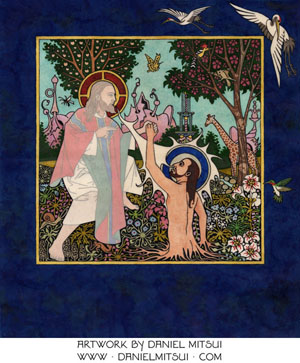
Because Mary is the new Eve, her fiat represents an undoing of Eve’s original sin. As noted in many medieval hymns, Ave, the beginning of the angelic salutation, is the reverse of Eva. I drew a picture of Eve with her name in reverse on the orphrey of Gabriel’s dalmatic.
The damask patterns on Mary and Gabriel’s garments, which are in the style of medieval millefleur tapestries, include several symbolic emblems: a unicorn and a lily, whose meaning has already been explained, and a peridexion tree that represents the Trinity. According to the Aberdeen Bestiary:
The perindens is a tree in India. Its fruit is sweet throughout and exceedingly pleasant; doves delight in it and live in the tree, feeding on it. The dragon is the dove's enemy; it fears the tree and its shadow, in which the doves dwell; and it cannot approach either the tree or its shadow. If the shadow lies towards the west the dragon flees to the east, and if the shadow falls towards the east, the dragon flees to the west. If it should happen that a dove is caught out of the tree or its shadow, the dragon kills it. Take the tree as God, the shadow as his son; as Gabriel says to Mary: The Holy Ghost shall come upon thee and the power of the Highest shall overshadow thee. Take the fruit to be the wisdom of God, that is, the Holy Spirit.
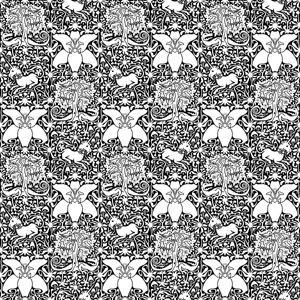
Mary is one of twelve Biblical figures for whom I have designed a signature carpet, to appear with her throughout the Summula Pictoria. The art historian Volkmar Gantzhorn argued in his book The Christian Oriental Carpet that carpets are traditional indicators of sanctity, like halos for the feet. Mary’s carpet includes the words virgo and mater written in orthogonal letters.

Throughout the Summula Pictoria, I depict halos according to a system that I myself invented. Saints of the Old Testament have silver or lunar halos, whereas saints of the New Testament have golden or solar halos. The Virgin Mary has a special place between the two Testaments; for this reason, her halo has a golden outer circle and a silver inner circle, with the light blue sky of day between them.
For angels, and for anyone who is divinely inspired, I draw the outer ring blazing, with tongues of flame reaching upward. God, in any of His three persons, has a halo with three internal bars, indicating the Trinity. On God the Son, I arrange these cruciformly. On the other persons, I do not necessarily place them at right angles.

In all drawings of the Summula Pictoria, I use the translucent calfskin for artistic effect, drawing certain details on the reverse side. These appear more or less distinct depending on how much light is shining through the drawing. Here, those details include the damask patterns; the shadows inside the chapel; the scenery outside the window; the face, hands, and feet of the archangel, the Hand of God the Father, and the dove representing the Holy Ghost.
Sacred artists, perhaps limited by their materials, have for centuries largely avoided the challenge of drawing non-incarnate beings in a distinctive way. For the most part, they have drawn or painted the figures or emblems representing God the Father and God the Holy Ghost as though they were physically present, or have avoided depicting them altogether.
My own practice is to draw these figures or emblems on the opposite side of the calfskin, so that their apparent bodies have a ghostly appearance, and are only fully visible when the drawing is held up to light. It is an imperfect solution to an impossible problem, but it is the best idea I have for now.
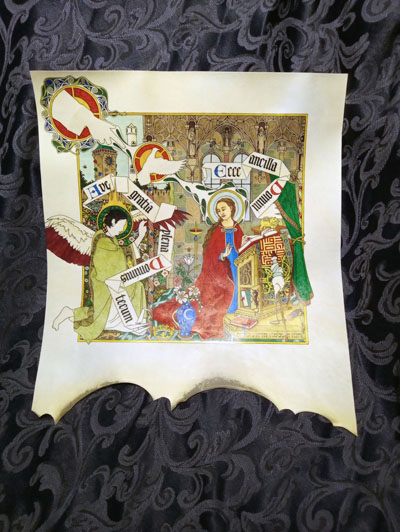
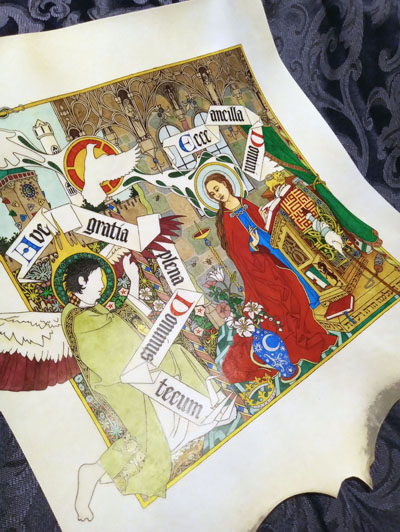
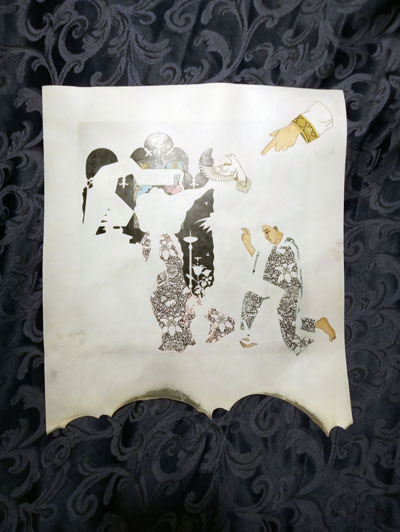
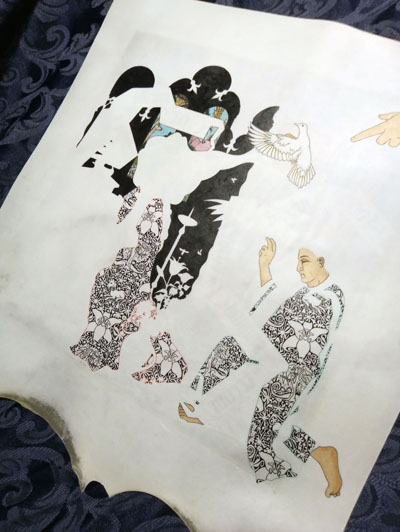
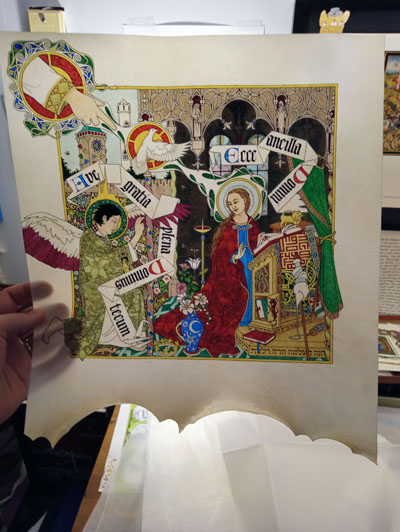
I drew this on the end of a piece of calfskin, which is why the bottom has an irregular edge.
Medium: Drawing, color ink on calfskin vellum
Dimensions: 12" × ~15"
Year: 2025
Open-edition giclée prints of this drawing are available. You may use the buttons below to pay via PayPal, debit card, or credit card. Be sure to confirm the shipping address.
|
Actual size art print: $160
|
24" × 30" large print: $320
|
200dpi digital download: $32

|
See this page for additional ordering instructions and general information. If you want to pay via a check or money order, please e-mail me at danielmitsuiartist@gmail.com.
